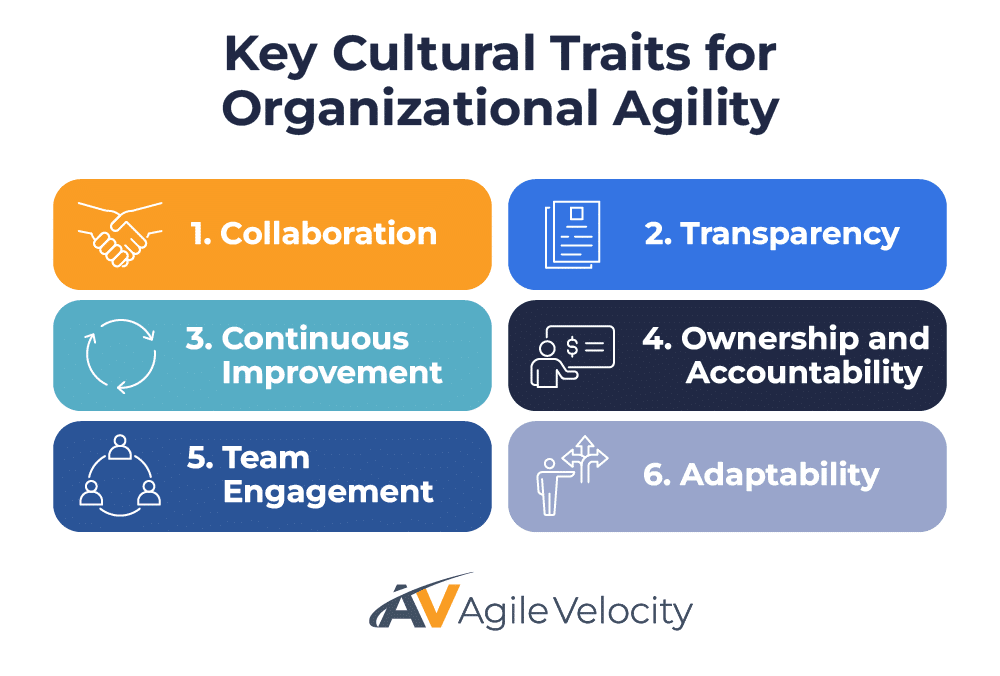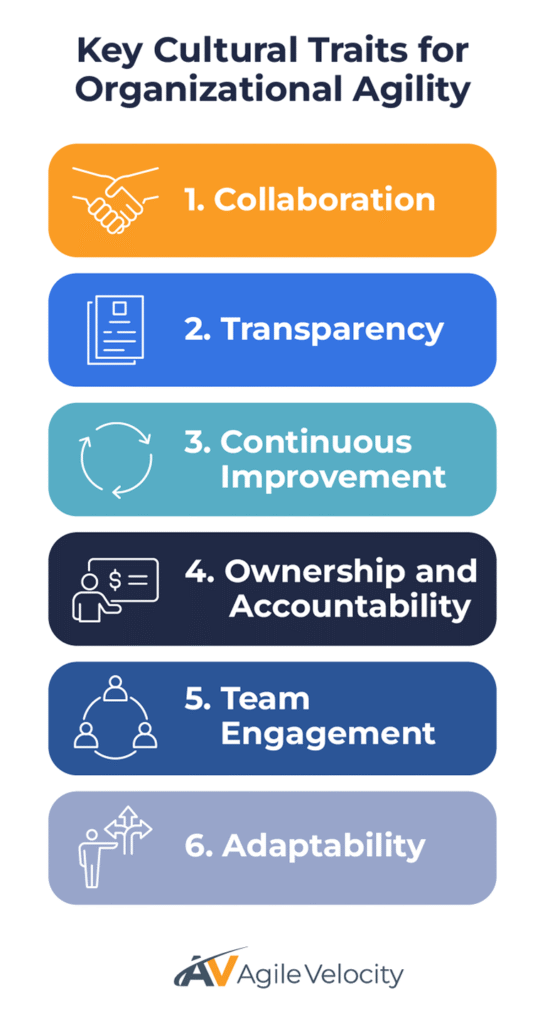Organizational agility is not a passing trend—it’s the engine of lasting success. In today’s rapidly evolving market, businesses must adapt quickly to rising customer expectations, and shifting demands. In fact, studies show that companies embracing an Agile Transformation can see productivity improvements of up to 30%. But true agility is built on culture: a workplace that fosters collaboration, adaptability, and continuous improvement. Without these cultural traits, even the best Agile frameworks may fall short.
This article serves as a comprehensive guide to understanding and implementing the essential cultural traits that underpin organizational agility, such as collaboration, transparency, continuous improvement, and accountability. By the end of this read, you should gain insights into how fostering a supportive culture can amplify the benefits of Agile frameworks like Scrum and Kanban. You will also learn practical steps to cultivate an Agile culture, overcome transformation challenges, and sustain lasting cultural evolution to maintain competitiveness in a rapidly changing market. These lessons can help unlock greater organizational adaptability, enhancing your capability to meet modern business demands efficiently.
The Connection Between Culture and Agile Shift
Culture shapes every decision and action within an organization. It’s the set of unwritten rules and values that guide problem-solving and communication. During an Agile shift, many companies focus on processes like Scrum or Kanban, but these frameworks work best when backed by a supportive culture.
Consider this: organizations with rigid, hierarchical decision-making can delay progress because staff may hesitate to act without approval. In contrast, a culture that encourages empowerment and open communication allows teams to make fast, informed decisions. When mission-important data, such as customer satisfaction rates or project completion times, underscores these changes, the impact becomes even clearer. Ultimately, a strong culture multiplies the value of Agile practices.
Ready to Drive Success?


Collaboration: The Cornerstone of an Agile Culture
Collaboration is the heartbeat of an Agile culture. It brings together diverse talents and ideas while breaking down silos that slow progress. Whether teams work in-person, remotely, or in a hybrid setup, effective collaboration fosters a unified effort that drives success.
Key points include:
-
- Cross-Functional Teamwork: Bringing together a range of skills to solve complex challenges. For example, Scrum Teams unite members from various disciplines to overcome obstacles collectively.
-
- Collective Problem-Solving: Shifting the focus from assigning blame to exploring solutions together, thereby fueling innovation.
-
- Open Communication: Regular practices, such as Daily Scrum events and shared dashboards, ensure that everyone remains informed and aligned.
Leaders can boost collaboration by continuously communicating lessons learned, finding ways to swiftly disseminate to improved practices.
Transparency: Building Trust and Achieving Alignment
Transparency builds trust by ensuring that everyone understands shared goals, progress, and challenges. When teams have a clear view of the big picture, they can adjust quickly and learn from setbacks. In organizations committed to openness, even mistakes become opportunities for growth.
To foster transparency:
-
- Share Clear Goals and Progress: Communicate targets (like Sprint Goals) and progress updates that are accessible to all.
-
- Discuss Challenges Openly: When obstacles are addressed transparently, teams can quickly identify effective solutions.
-
- Involve Everyone in Decision-Making: Including all team members in decisions builds collective ownership and accountability.
This approach not only creates alignment but also establishes a resilient culture ready to tackle new challenges.
Continuous Improvement: The Foundation of Lasting Agility
Continuous improvement involves always seeking to enhance processes and skillsets, even through small incremental changes. Agile frameworks like Scrum and Kanban depend on regular review and adaptation, turning each cycle into a step forward.
Consider these practices:
-
- Leverage Feedback Loops: Frequent retrospectives and data reviews (such as tracking Sprint velocity) help teams become more predictable.
-
- Foster Experimentation: Encourage small-scale tests to see if minor enhancements can drive efficiency.
-
- Promote Self-Reflection: Simple questions like “What went well?” and “What can we improve?” spark ongoing learning.
A commitment to continuous improvement lays the groundwork for innovation that keeps teams competitive and responsive.
Ownership and Accountability: Empowering Teams to Deliver Results
Agile success depends on each individual taking responsibility for their contributions. Whether it’s a Scrum Master ensuring smooth event execution or a Product Owner managing the Product Backlog, every role is vital in driving success.
Steps to build this culture include:
-
- Define Roles Clearly: While roles such as Scrum Master and Product Owner have specific duties, effective teams remain flexible and supportive beyond strict definitions.
-
- Empower Decision-Making: Remove unnecessary layers of approval, enabling teams to act swiftly.
-
- Base Decisions on Data: Use objective metrics such as Sprint velocity or Kanban throughput to guide decisions.
-
- Cultivate Constructive Feedback: Encourage learning from mistakes rather than assigning blame, fostering continuous improvement.
When every team member feels responsible for outcomes, the organization benefits from quicker decision-making and enhanced innovation.
Balancing Fun with Purpose: Elevating Team Engagement
A workplace that blends clear purpose with a sense of enjoyment nurtures creativity and long-term engagement. Incorporating fun not only boosts morale but can also reinforce professionalism when done right.
Strategies include:
-
- Celebrate Wins: Recognize achievements ranging from finishing a Sprint successfully to reaching key project milestones.
-
- Foster Friendly Challenges: Organize light contests and innovation challenges to inject energy into routine tasks.
-
- Encourage Informal Learning: Share personal interests during brief sessions to build team bonds without compromising focus.
-
- Adopt Fun Rituals: Simple practices like themed days or short team gatherings can elevate morale and productivity.
A balance of serious work and enjoyable interactions helps maintain high levels of motivation and readiness to meet challenges.
Agility in Action: Cultivating Adaptability in Teams
Adaptability keeps organizations responsive and able to pivot in the face of changing market conditions or unexpected challenges. Agile teams view change as an opportunity to improve and evolve.
To nurture adaptability:
-
- Embrace Change: View shifts in strategy as chances to enhance value delivery.
-
- Encourage Quick Experimentation: Utilize short cycles of trial and error to determine when to iterate or pivot.
-
- Promote a Growth Mindset: When mistakes are embraced as learning opportunities, team members become more comfortable taking risks.
-
- Share Success Stories: Highlight examples of rapid pivots that have led to improved customer outcomes, reinforcing the benefits of adaptability.
By weaving adaptability into everyday practices, organizations can transform uncertainty into a strategic advantage.
Leveraging Path to Agility® Navigator for Cultural Transformation
Transforming your culture may seem daunting, but a clear roadmap can make the journey manageable. The Path to Agility approach through Agile Velocity, along with the Path to Agility® Navigator software created by the experts at Agile Velocity offers a structured, data-driven approach to bridge the gap between your current state and the culture required for true Agile Transformation.
With this approach and this tool, organizations can:
-
- Identify cultural challenges that hinder collaboration.
-
- Enhance transparency by aligning leadership with team decisions.
-
- Embed continuous improvement as a regular practice.
-
- Monitor progress through measurable metrics that guide ongoing enhancements.
Path to Agility Navigator turns abstract concepts into specific, manageable actions, assisting leaders in prioritizing the steps necessary for sustainable cultural change.
Practical Steps to Cultivate an Agile Culture
Building an Agile culture is an ongoing process. Here are clear, actionable steps to begin transforming your workplace:
-
- Evaluate Your Culture: Use surveys, one-on-one conversations, and tools like Path to Agility Navigator to identify strengths and opportunities for improvement.
-
- Invest in Training and Coaching: Provide Agile training and support these sessions with hands-on Agile Coaching.
-
- Strengthen Collaboration: Implement daily syncs and cross-functional team events to ensure every voice is heard.
-
- Promote Transparency: Regularly share goals and progress with all team members, and discuss challenges openly.
-
- Celebrate Improvement: Recognize achievements big and small to foster a mindset of continuous progress.
-
- Link Work to Business Goals: Demonstrate how daily tasks contribute to strategic objectives, boosting employee motivation.
-
- Create Flexible Workspaces: Develop physical and virtual environments that support both collaboration and focused work.
-
- Gather Feedback Daily: Use regular retrospectives to collect insights and shape adaptations.
-
- Lead by Example: When leaders model transparency and adaptability, they inspire the entire team to follow suit.
-
- Make Agile a Daily Habit: Integrate Agile practices into everyday routines, ensuring that improvement becomes a continuous endeavor.
Additionally, many organizations have found success by pairing advanced digital collaboration tools with guided Agile Coaching. These tools reinforce the behaviors that drive agility, helping teams adopt new practices more quickly and consistently. A thoughtful combination of training, technology, and support can accelerate cultural shifts for lasting gains.
Challenges in Shifting Culture and How to Overcome Them
Every transformation comes with its own set of challenges. Common obstacles include:
Resistance to Change
Employees may feel discomfort when routines are altered. Clear and consistent communication about the benefits of Agile can help ease these concerns.
Fear of Failure
A culture that penalizes mistakes can stifle innovation. Reward learning and view setbacks as opportunities to enhance processes.
Lack of Agile Expertise
Without proper training, even well-designed frameworks may struggle. Investing in ongoing workshops and seasoned Agile Coaches is essential.
Distributed Teams
Creating a united culture among remote or globally dispersed teams presents unique obstacles. Structured virtual events and regular online sessions help foster connection.
Misalignment with Business Goals
If cultural changes are perceived as disconnected from core business objectives, motivation can suffer. Always tie cultural initiatives to measurable outcomes, tracking progress with Path to Agility Navigator.
Transitioning to an Agile culture demands commitment, communication, and a willingness to evolve. While challenges such as resistance to change and fear of failure can be significant, solutions like clear communication, continuous learning, and leveraging technologies can cater to these hurdles effectively. As organizations strive to blend agility into their fabric, it’s crucial to link these transformations back to strategic business goals, ensuring that every cultural shift adds tangible value.
By fostering an environment of collaboration, transparency, and continuous improvement, businesses not only adapt to changing markets but also position themselves to lead and innovate. Embracing and cultivating Agile principles reflects not just a strategic shift but a comprehensive transformation that benefits every level of the organization, from individual team members to overarching business success.
Measuring and Sustaining Cultural Transformation
Ensuring that cultural evolution is not only initiated but also maintained requires continuous measurement. Organizations should implement regular assessments to monitor employee engagement, transparency, and adaptability. Tools such as anonymous surveys, one-on-one interviews, and performance metrics provide leaders with insights into the effectiveness of new practices.
Regular reflection sessions, similar to Sprint Retrospectives, allow teams to discuss successful strategies and identify remaining obstacles. By linking these reflections to measurable outcomes—like shorter product delivery times or improved customer satisfaction—organizations can make informed decisions about future enhancements. Establishing clear success metrics and reviewing them periodically fosters accountability and helps sustain the momentum of continuous improvement initiatives.
Sustaining cultural transformation also means fostering continuous learning. Encouraging participation in Agile training workshops or industry events builds a knowledge-rich environment that supports ongoing experimentation. Mentorship programs and cross-functional collaborations further embed a learning culture, enabling teams to adapt as market conditions evolve. With consistent feedback loops and measurable progress, organizations can maintain the pace of change while reinforcing the cultural traits that drive lasting innovation.
For those looking to align culture more closely with business priorities, investing in Lean Portfolio Management services can help structure and prioritize work at scale. This approach ensures resources are directed toward initiatives that deliver the most value to customers and stakeholders.
Future Outlook: Embracing New Trends in Agile Culture
Looking ahead, organizations must stay receptive to emerging trends that influence Agile practices and cultural evolution. Embracing digital innovations, nurturing inclusive leadership, and integrating advanced collaboration tools can further enhance organizational agility. As teams become more diverse and globally distributed, adapting communication styles will become increasingly important to maintaining a vibrant Agile culture.
Sustaining an Agile Culture for Long-Term Success

A strong, adaptive culture is the foundation of true organizational agility. When collaboration, transparency, continuous improvement, and accountability unite, a transformation evolves from an aspiration into a lasting reality. Tools like Path to Agility® Navigator help convert abstract concepts into actionable insights, guiding measurable cultural change for sustainable growth.
By mastering the art of Agile Transformation experts through continuous improvement practices, teams can stay competitive and responsive. Now is the time to act. Consider engaging with seasoned coaching professionals or exploring professional Agile training workshops to begin your journey toward a dynamic and responsive work culture.



